Ever wondered what powers your car’s electrical components, from the headlights to the radio? The answer lies in your car battery. But, how many volts is a car battery?
A car battery commonly holds 12.6 to 15 volts, contrary to its common label of a “12-volt” battery. In fact, a fully charged battery should measure at least 12.6 volts when the engine is off. When the engine is running, the voltage should read between 13.7 and 14.7 volts.
Truth is, anything less than 12.2 volts without the engine running is considered a bad or weak battery. Don’t risk getting stuck with a vehicle that can no longer start. To address the low voltage issue, consider using a trickle charger to rejuvenate the battery or, if necessary, replace the battery entirely.
Let’s unpack all the details about car batteries. Everything from their voltage ranges, how to measure them and when it’s time for a replacement.
So, let’s dive in and illuminate the mystery behind your car’s energy source!
Understanding How Many Volts is a Car Battery
Simply put, a car battery voltage can vary depending on various factors such as the type of battery, its state of charge, and whether the engine is running or not.
Normal Voltage Range of a Car Battery
A car battery has a normal voltage range of 12.6 volts. This means the resting or idle state of a battery would show roughly 75 percent charge.
Yet, with the engine running, this range should be somewhere between 13.5 and 14.7 volts to run all of the car’s systems. But when fully charged and not being used, a car battery should hold around 12.6 volts of power.
What Are The Factors That Affect Car Battery Voltage?
Many things can change car battery voltage. Cold weather can lower it, while heat can do the same. A battery gets weaker with age too, which also changes its power level. Using lights or radio when the engine is not on drains energy as well.
If a car sits for a long time without being driven, the battery may drop below 12 volts and need charging again to bring it back up to full strength of 12.6 volts or more during use.
What is the Recommended Battery Voltage While a Car is Running?
A running car needs a battery with a good charge level, which should be between 13.7 and 14.7 volts.
Simply put, that is the optimum range for battery voltage while driving. But what about when the engine is off? Well in that case, the resting or fully charged car battery should have at least 12.6 volts to keep it healthy and to make sure it can start the car.
Understanding Amps and Volts in a Car Battery
Car batteries are essential for powering the electrical systems in a car. They are typically categorized as 12 volts, and can produce up to 600 amps of electric power. The capacity of an average car battery is around 48 amp hours. This means it can deliver 1 amp for 48 hours or 2 amps for 24 hours when fully charged.
Comparison of Different Car Battery Types
Car batteries come in various types, each with their own unique characteristics and uses. The table below provides a comparison of some common types of car batteries and their respective voltage levels.
| Battery Type | Voltage | Characteristics |
|---|---|---|
| Lead-Acid Battery | 12 Volts | These are the most common car batteries used, primarily because of their low cost. They are rechargeable and reliable for starting the car. |
| Absorbent Glass Mat (AGM) Battery | 12 Volts | AGM batteries are designed to withstand frequent draining and recharging cycles. They are more durable and tend to have a longer lifespan than traditional lead-acid batteries. |
| Lithium-Ion Battery | 3.6 – 3.7 Volts (per cell) | Lithium-ion batteries are lightweight and have a high energy density. They are commonly used in electric and hybrid vehicles. |
How to Test Car Battery Voltage
To test car battery voltage, you can use a multimeter to measure the electrical potential of the battery.
Using a Multimeter
To test the voltage of a car battery, here are the steps to follow:
- Turn the key of the vehicle to the run position.
- Set your multimeter to DC voltage mode.
- Connect the red probe of the multimeter to the positive terminal of the battery.
- Connect the black probe of the multimeter to the negative terminal of the battery.
- Read and write down the voltage reading displayed on your multimeter.
Interpreting voltage readings
To interpret voltage readings from a car battery, you need to understand the different charge levels. A reading below 12.0 volts usually means the battery is dead and needs to be replaced.
On the other hand, a reading between 12.65-12.77 volts suggests the battery is fully charged. If the voltage falls within 12.45-12.54 volts, it indicates a battery with about 75% charge remaining. A reading of 12.24-12.29 volts corresponds to a battery that is around 50% charged.
Remember that these voltage ranges can vary slightly depending on factors such as temperature and the type of battery being used in your car. By interpreting these voltage readings accurately, you can assess the health and performance of your car battery effectively.
What is The Minimum Voltage Needed to Start a Car?
The minimum voltage needed to start a car is usually around 11.8 volts, but in some cases, it might be possible to start the car at 9 volts. However, for optimal performance and reliability, it is recommended to have a car battery with a voltage rating of at least 12.4 volts.
If your car battery has a reading of 9 volts or lower, it may indicate a low charge or potential issues with starting the car. In such cases, it’s best to have the battery tested and possibly charged before attempting to start the vehicle again.
What is The Average Overnight Voltage Loss?
A car battery can lose some voltage overnight, especially if it’s not in good condition. A well-maintained battery might lose about 1-2% of its voltage while the car is off. This is because all 12-volt batteries have a self-discharge rate, which means they gradually lose voltage over time.
If there’s a significant drop in voltage overnight, it could be a sign that something is wrong with the battery or its charging system. It’s important to monitor the battery’s voltage regularly to catch any potential issues and prevent unexpected breakdowns.
When Should You Replace a Car Battery?
One of the clear indications of a failing battery is a weak engine start. When you attempt to turn on the vehicle, the engine may take longer than usual to roar to life. Sluggish cranking is another symptom to watch out for.
Signs of a Failing Battery
- Weak engine start
- Sluggish cranking
- Insufficient voltage
- Dead cell
- Low voltage threshold
- Aging battery
Importance of Maintaining Healthy Voltage
Maintaining a healthy voltage in your car battery is extremely important. It ensures that your battery functions properly and avoids the need for replacement.
However, if you plan to let your car sit for an extended period of time, be sure to add a trickle charger. This will keep your battery from losing all its charge, leaving you unable to start the vehicle. A reliable and safe trickle charger is available at most auto parts store for less than $30 dollars.
Remember, the voltage of your car battery directly affects its performance and starting capability, so maintaining a healthy voltage level is essential for reliable operation of your vehicle.
Final Thoughts
In conclusion, the voltage of a car battery is around 12.6 volts, although it can reach closer to 15 volts. The ideal voltage range for a car battery is between 12.4 and 12.6 volts when the engine is not running.
Having the right voltage is important for powering the electrical components in your vehicle and starting the engine smoothly.
And remember, sudden swings in temp cold or hot will affect battery voltage and performance. So, make sure to regularly check and maintain your car battery’s voltage so you never end up with a vehicle that is unable to start.

Managing Editor
Christopher is an automotive technical writer. When he’s not at the local autocross event, he can often be found working on one of his cars. Specializes in automotive class action law, industry trends, and automotive maintenance. Email me direct, or learn more about us

